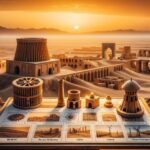Imagine stepping back in time to a city built not for daily life, but as a breathtaking stage for imperial power and splendor. That’s Takht-e Jamshid, also known as Persepolis—a UNESCO World Heritage site in Iran that whispers tales of the mighty Achaemenid Empire. This isn’t just a collection of ancient stones; it’s a living history book, chronicling kings, conquests, and extraordinary artistry. This article will explore its magnificent architecture, uncover fascinating stories etched in stone, and offer practical advice for your own journey to this remarkable site. Prepare to uncover the secrets of this Persian treasure.
A Journey Through Time: The Rise and Fall of Persepolis
More than just a city, Persepolis was a powerful statement—a dazzling display of the Achaemenid Empire’s wealth, power, and sophisticated civilization. Construction, beginning around 518 BC under Darius the Great and continuing under Xerxes I and Artaxerxes I, spanned over a century, showcasing the empire’s immense resources and ambition. It wasn’t designed for everyday living but as a meticulously planned ceremonial capital, intended to impress visitors and showcase the empire’s might during grand ceremonies and receptions. The sheer scale of Persepolis is breathtaking; its impact is undeniable.
The Achaemenid Legacy: A Story Etched in Stone
The Achaemenid Empire, spanning vast territories, reached its zenith during the reigns of Darius I, Xerxes I, and Artaxerxes I. Persepolis, their ceremonial capital, reflects this power. Built largely from dark grey marble, its massive structures served as potent symbols of the empire’s wealth, advanced engineering, and sophisticated architectural knowledge. The city’s grandeur served as a powerful statement of imperial authority, impressing visitors and reinforcing the empire’s image.
Architectural Marvels: Palaces, Gates, and Halls of Power
Persepolis boasts iconic buildings, each meticulously designed to convey imperial power. The Apadana Palace, a colossal structure likely the main venue for grand royal gatherings, featured immense columns and incredibly detailed carvings, or bas-reliefs. These weren’t merely decorative; they were carefully planned scenes of royal processions and tributes, demonstrating the empire’s awe-inspiring power and vast reach. The Gate of All Nations, a monumental gateway, welcomed dignitaries and ambassadors from across the empire, a symbol of its far-reaching influence. The Treasury, though smaller, was equally important, possibly used to house royal treasures, reflecting the empire’s accumulated wealth. The unfinished Hundred-Column Hall hints at the original ambitious scope of the city. These structures weren’t just buildings; they were powerful symbols of the empire’s wealth, power, and cultural influence.
Whispers from the Past: Decoding the Stories in Stone
The intricate reliefs adorning Persepolis’ structures are more than just decoration; they’re living history. They depict royal processions, battles, and emissaries from across the vast empire, providing invaluable insights into Achaemenid culture, military might, and diplomacy. Scholars continue to study these carvings, deciphering their meanings and uncovering new insights into the daily lives, religious beliefs, and political climate of the time. Some experts believe these carvings served as a sophisticated form of political propaganda, reinforcing the empire’s strength and the diversity of its subjects. Others suggest that the full significance is still being understood.
Alexander’s Conquest and the City’s Demise: A Tragedy in Stone
The story of Persepolis takes a heartbreaking turn with Alexander the Great’s conquest in 330 BC. The city, a symbol of Achaemenid power, suffered a devastating fire. Whether this was intentional or accidental remains a topic of scholarly debate. Some historians suggest it was a deliberate act of destruction, while others point to the potential for accidental fires during warfare. Regardless of the cause, the fire left an indelible mark, transforming the vibrant city into the awe-inspiring, albeit scarred, ruins we see today. This destruction ironically heightened the site’s enduring mystery and allure.
Persepolis Rediscovered: From Obscurity to World Heritage Site
Early travelers and explorers mentioned the ruins, sparking curiosity. However, major archaeological efforts only began in the 20th century, with figures like André Godard leading the charge in restoring and understanding the site. The painstaking work of archaeologists and preservationists has been monumental. Its recognition as a UNESCO World Heritage site underlines Persepolis’ global significance. Ongoing efforts highlight the site’s cultural importance for scholars and visitors alike. Preserving Persepolis presents ongoing challenges, including environmental factors and human activity.
Exploring Persepolis Today: A Traveler’s Guide
Visiting Persepolis is an unforgettable experience, a journey through millennia. The scale of the structures, the intricate carvings, and the sheer weight of history create a lasting impression. To enhance your visit:
Planning Your Trip: A Practical Guide
- Getting There: Persepolis is near Shiraz, accessible by taxi, bus, or guided tour (recommended for historical context).
- Ticketing: Check the official website for current entrance fees.
- Best Time to Visit: Spring (March-May) and autumn (September-November) offer pleasant weather. Summers are extremely hot.
- What to Pack: Comfortable walking shoes, sunscreen, a hat, and plenty of water are essential.
- Dress Code: Dress modestly out of respect for the site and local culture.
Key Structures of Takht-e Jamshid
| Structure | Description | Significance |
|---|---|---|
| Apadana Palace | Massive audience hall; huge columns; detailed carvings. | Center of imperial power; hosted massive gatherings; a symbol of royal authority and magnificence. |
| Gate of All Nations | Imposing gateway; depicted people from across the empire. | Represented the vastness of the empire and its diverse subjects. |
| Treasury | Strong, well-built storage. | Likely held royal treasures; demonstrated the empire’s wealth and sophisticated architecture. |
| Hundred-Column Hall | Enormous, unfinished hall. | Demonstrates the scale of the original plan; unfinished state adds an element of historical mystery. |
Beyond the Stones: Persepolis’ Enduring Legacy
Persepolis remains a potent symbol of Persian identity, deeply embedded in the nation’s culture, art, and literature. Its images and stories resonate in contemporary Iranian society, providing a sense of continuity with a glorious past. A visit offers a profound understanding of Persia’s enduring cultural legacy and its impact on the modern world. The site is more than just stones; it’s a testament to a civilization’s achievements and aspirations.
Comparing Empires: Persepolis in Context
Comparing Persepolis with other ancient capitals, such as Babylon or Susa, provides a broader appreciation of the ancient Near East’s diverse cultures and civilizations. While each site has its unique characteristics, comparing them reveals common themes of power, ambition, and the enduring human desire to leave a lasting mark on the world. Such comparisons highlight the complexities of ancient societies and their interconnectedness. This site remains subject to ongoing research and interpretation. Many questions about specific events and interpretations continue to be debated. New discoveries and insights frequently emerge, continually refining our understanding of this remarkable ancient wonder and its place in history.
Persepolis: A Journey Through Persian History and Architectural Mastery
Persepolis wasn’t built for daily life; it was a carefully constructed statement of power, a breathtaking display of wealth and architectural prowess. Its construction, starting around 518 BCE under Darius the Great and continuing for over a century under his successors, reveals incredible resources and ambition. The city’s very design was intended to awe visitors and leave a lasting impression of the empire’s might.
Architectural Marvels: Beyond the Obvious
The scale of the complex is staggering. The Apadana Palace, a massive hall supported by giant columns and adorned with incredibly detailed carvings, is a testament to this. These carvings, narrating the empire’s story, depict processions, tributes from distant lands, and glimpses into daily life within the royal court. The Gate of All Nations, a monumental entrance, symbolized the empire’s incredible diversity. The sheer logistical feat of building Persepolis—the movement of materials, coordination of workers, and skill of the artisans—is astonishing. Scholars still debate the exact methods used, but it’s clear a massive effort went into its creation. It was a project of monumental scale, reflecting the ambition of the empire itself.
Stories in Stone: Unraveling Ancient Life
The bas-reliefs are not mere decorations; they are invaluable historical documents offering a window into Achaemenid life, customs, and beliefs. They depict the empire’s military might, economic prosperity, and incredible cultural diversity. Some experts suggest that specific scenes represent significant events, offering valuable insights into the empire’s history. Other interpretations are possible, highlighting the ongoing nature of historical analysis. The sheer level of detail is remarkable; you can almost hear the sounds of the processions and sense the energy of the scenes depicted.
From Grandeur to Destruction: A City’s Demise
Alexander the Great’s conquest in 330 BCE marked a tragic turning point. While the extent of the destruction is still debated, it’s clear that the city suffered significant damage. The once-magnificent structures were ravaged, leaving behind the powerful yet heartbreaking ruins we see today. It’s a sobering reminder of the ephemeral nature of empires and the relentless march of time.
Persepolis Today: Preserving a Legacy
Despite centuries of neglect and destruction, Persepolis endures. Its UNESCO World Heritage Site status affirms its global importance and unique contribution to architectural history. Archaeologists continue to excavate the site, uncovering its secrets. Conservation efforts are crucial to protect these precious remains for future generations. Ongoing research investigates construction materials, techniques, and the environmental impact on preservation. Preserving Persepolis is an ongoing challenge, impacted by weather and erosion. Active efforts are vital to ensure future generations can appreciate this masterpiece of ancient architecture and engineering. The ongoing work highlights the dynamic interplay between past and present; our understanding of Persepolis is constantly evolving with new discoveries and interpretations. The story of Persepolis remains a living one, continually unfolding.
- Longtown, UK: Your Complete Guide to History, Accommodation, and Activities - November 29, 2024
- Hexham Bus Station: Times, Routes & Amenities Guide - November 29, 2024
- How to Attract Dragonflies: Create a Thriving Habitat in Your Garden - November 29, 2024















